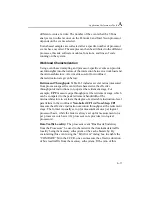
IA-32 Intel® Architecture Optimization
9-18
processor to enter the lowest possible C-state type
(lower-numbered C state has less power saving). For example,
if Core 1 meets the requirement to be in ACPI C1 and Core 2
meets requirement for ACPI C3, multi-core-unaware OS
coordination takes the physical processor to ACPI C1. See
Figure 9-6.
2.
Enabling both core to take advantage of Intel Enhanced Deeper
Sleep:
To best utilize processor-specific C-state (e.g., Intel Enhanced
Deeper Sleep) to conserve battery life in multithreaded
applications, a multi-threaded applications should synchronize
threads to work simultaneously and sleep simultaneously using
OS synchronization primitives. By keeping the package in a
fully idle state longer (satisfying ACPI C3 requirement), the
physical processor can transparently take advantage of
processor-specific Deep C4 state if it is available.
Multi-threaded applications need to identify and correct
load-imbalances of its threaded execution before implementing
coordinated thread synchronization. Identifying thread
Figure 9-6
Progression to Deeper Sleep
Thread 1
(core 1)
Thread 2
(core 2)
CPU
Active
Sleep
Active
Active
Sleep
Sleep
Deeper
Sleep
Summary of Contents for ARCHITECTURE IA-32
Page 1: ...IA 32 Intel Architecture Optimization Reference Manual Order Number 248966 013US April 2006...
Page 220: ...IA 32 Intel Architecture Optimization 3 40...
Page 434: ...IA 32 Intel Architecture Optimization 9 20...
Page 514: ...IA 32 Intel Architecture Optimization B 60...
Page 536: ...IA 32 Intel Architecture Optimization C 22...















































